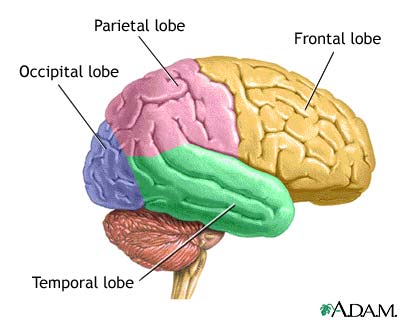Friday, March 12, 2010
"Cheat Sheet"
Cheet Sheet:
Parts of the Brain:
Cerebeum: Where the thinking happens and where the 4 lobes of the brain are.
Cerebellum: Balance, and works with voluntary muscles.
Medulla Olongata: Controls movements in the face and neck.
Thalmus: Emotional responses, transfers information from the body to specific parts of the brain.
Hypothalamus: signal, hunger and thirst.
Corpus Callosum: Connects the sides of the brain, dominant hand learning.
Pons: Bridge for signals.
Spinal Cord: Holds nerves except for the head, reflexes, motor skills.
Pituitary Gland: Produces and releases hormones.
Lobes of the Brain:
Frontal: Controls smell, thinking, and emotions.
Parrietal: Controls taste, touch, and movement.
Occipital: Controls vision.
Temporal: Controls hearing, emotion, and memory.
Parts of a Neuron:
Axon: Carries impulses away from the cell body.
Dendrites: Carries impulses to the cell body.
Synapse: Space between two neurons.
Mylin Sheath: Insulation for the Axon.
Nervous System:
Central Nervous System (CNS): Inside the brain and spinal cord.
Peripheral Nervous System(PNS): Outside the brain and spinal cord.
Other Parts of the Brain:
Hemespheres: The right and left sides of the brain (2).
Hippocampus: Learning and memory.
Sulci: Grooves in the brain.
Gyri: Bumps on the brain.
Gray Matter: Neuron cell bodies.
White Matter: Axons and dentrites.
Brain Stem: Controls involuntary functions your body needs to survive.
Thursday, March 11, 2010
Random Facts About the Brain
The Cerebum makes up 85% of your brain*.
There are NO pain receptors in the brain.
You have 100,000 mile of blood vessels in the brain.
*You can also find this fact in the 5 Main Parts of the Brain.
More Parts of the Brain
- Hemisphers: The right and left sides of the brain.
- Sulci: Groves on the brain.
- Gyri: Bumps on the brain.
- Grey Matter: Neuron cell bodies.
- White Matter: Axons and dendrites.
Parts of a Neuron
- Dendrites: Carry impulses TO the cell body.
- Axon: Carries impulses AWAY FROM the cell body.
- Cell Body: Self Explanatory.
- Nucleus: Self Explanatory.
- Synpase: The space between two neurons.
Wednesday, March 10, 2010
Nervous Systems
- Central Nervous System (CNS): Made up of the brain and spinal cord.
- Peripheral Nervous System (PNS): Outside of the brain and spinal cord.
Other Parts of the Brain
- Medulla Oblongata: Controls movement in the face and neck.
- Thalmus: Emotional Responses
- Hypothalamus: Signals hunger and thirst
- Corpus Callosum: Connects the sides of the brain, remembers dominant side learning
- Pons: Bridge for signals across the brain
- Spinal Cord: Holds most of the nerves except the head, reflexes, and motor skills
- Brain Stem: Connects Spinal Cord to Spinal Cord
Tuesday, March 9, 2010
The Lobes
2. Occipital: Controls the sense of vision.
3. Tremporal: Where hearing is interperated.
4. Parietal: Interprets sesations (pain, pressure, touch, hot, and cold).
Information from the Structure of the Brain Worksheet
Friday, March 5, 2010
The 5 Parts of You Brain
1. Cerebum: This is the biggest part in your brain, and it is 85% of your brain's weight. This is the part of your body that thinks and moves your voluntary muscles (arms, legs). The cerebum has to sides (right: creative, left: logic).
2. Cerebellum: This is at the back of your brain and right below your cerebum. The cerebellum is only 1/8 the size of the cerebum. This part of your brain contrls balance.
3. Brain Stem: This is in front of the cerebellum and below the cerebum. The brain stem is in charge of involentary muscels and other things your body needs to survive.
4. Pituitary Gland: This is only about the size of a pea. The job of the pituitary gland is to make and give out hormones. This controls your amount of sugars and water in the body. This also plays a part in keeping you metabolism going.
5. Hypothalamus: This works as you brain's thermostat. This knows how warm your body should be. If your body is warm it says "sweat" if your body is cold it says "shiver". Both of these get your temerature back to normal.



